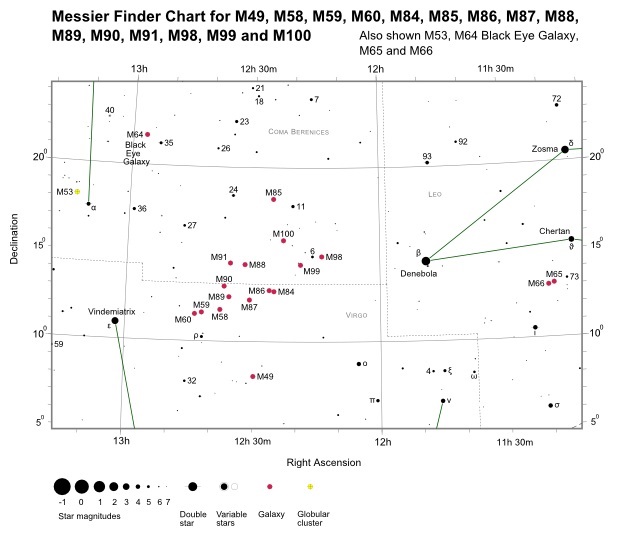M89 is another member of the Virgo Cluster of galaxies. It's a small magnitude +10.0 elliptical galaxy (type - E0) discovered by Charles Messier on March 18, 1781. On this bumper night for Messier he also discovered seven other Virgo galaxies and re-discovered globular cluster M92 in Hercules. Recent observations indicate that M89 may be nearly perfectly spherical in shape. This is unusual because all other known ellipticals are elongated. However, it's possible that the spherical nature of M89 is purely a visual affect resulting from its orientation from our perspective.
The galaxy is not as bright as some other group members and therefore a challenging small telescope object. Messier's original discovery observation acknowledges this: "extremely faint and pale and it's not without difficulty that one can distinguish it". The galaxy is best seen with large telescopes but generally featureless and rather unexciting through most amateur instruments.
M89 is located in Virgo just south of the Virgo-Coma Berenices constellation boundary. It's positioned roughly 60% along an imaginary line connecting stars, Denebola (β Leo - mag. +2.1) and Vindemiatrix (ε Vir - mag. +2.8). Slightly brighter spiral galaxy M90 is 0.75 degrees northeast of M89. One degree southeast of M89 is fine barred spiral galaxy M58 with supergiant elliptical galaxy M87 located about a degree west of M89.
The Virgo galaxies are best seen during the months of March, April and May.


When viewed through a 200mm (8-inch) telescope M89 appears as a faint, round, small featureless diffuse ball of light. It has a total apparent diameter of about 5 arc-minutes although visually it's about half this size. The view somewhat resembles a distant globular cluster but even larger scopes fail to reveal much more.
M89 is 55 million light-years distant which corresponds to a spatial diameter of 80,000 light-years. The galaxy also features a surrounding structure of gas and dust that extends up to 150,000 light-years from the centre. It's estimated to contain 100 billion stars.
M89 Data Table
| Messier | 89 |
|---|---|
| NGC | 4552 |
| Object Type | Elliptical galaxy |
| Classification | E0 |
| Constellation | Virgo |
| Distance (kly) | 55000 |
| Apparent Mag. | 10.0 |
| RA (J2000) | 12h 35m 40s |
| DEC (J2000) | 12d 33m 23s |
| Apparent Size (arc mins) | 5.1 x 4.7 |
| Radius (light-years) | 40,000 |
| Number of Stars | 100 Billion |